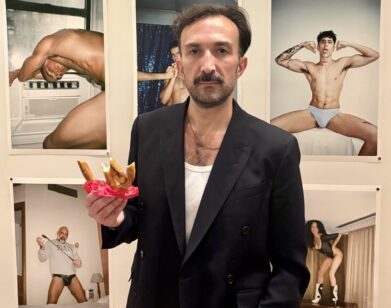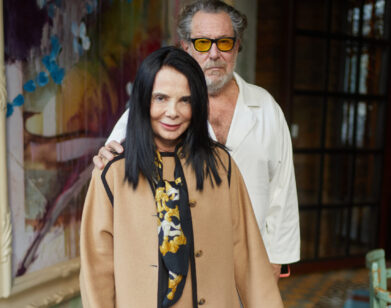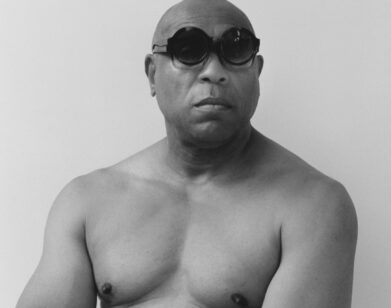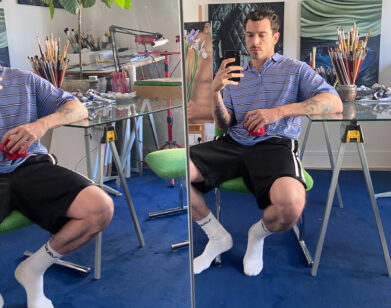Get With the Program
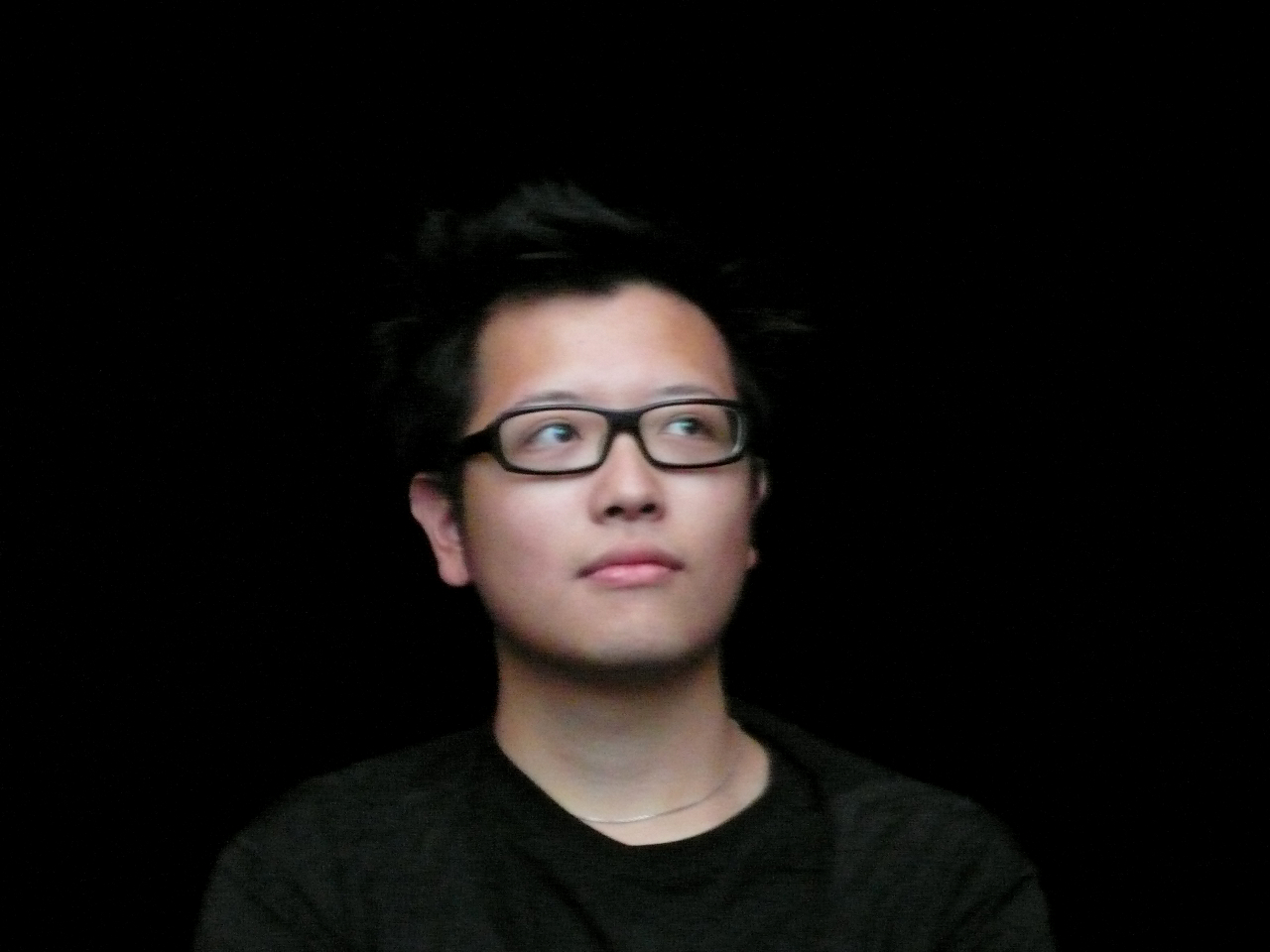
Installation shot of Surface Values, by Eemil Karila, at PROGRAM, Berlin.
Carson Chan wants us all to think a little harder about architecture. That’s why, in 2006, he co-founded PROGRAM: Initiative for Art + Architecture, along with fellow Harvard Design alumnus Fotini Lazaridou-Hatzigoga. Part gallery, part think-tank, workshop, library, salon, and artists’ residence, the initiative stands out among Berlin-Mitte venues not only for its critical approach to art and architecture but also in its sense of community-building. In a city with more than its share of expatriate-run venues, few other spaces set out to create the kinds of productive networks and cross-pollinations—between architects and artists, but also musicians, curators, critics—that PROGRAM has worked on in its still young existence. “Surface Values,” an exhibition by Finnish artist Eemil Karila, opened there last Thursday; an examination (under UV rays) of the mechanics behind the custodial maintenance of the old “white cube,” the show perfectly highlights PROGRAM’s ever-critical attitude towards the function of those spaces we so often take for granted.
VICTORIA CAMBLIN: How did you come to work with Eemil?
CARSON CHAN: We met about three years ago when he was living in Berlin. He was working with a space, now in Oslo, called 0047, which was a Berlin hub for Scandinavian artists. Eemil was dealing with Finnish identity at the time—he was doing a project about Santa Claus—and I was curating a show on Scandinavian social design and how it can be enacted through art and architectural practices. When he showed me images of his new work recently, like the one we are currently showing, I was eager to exhibit it in Berlin. It’s a piece in which he collaborates with the cleaning staff of the gallery or museum, trying to reveal the various players that contribute to transforming spaces into institutions.
VC: What does your cleaning staff consist of?
CC: We have two cleaning ladies.
Installation shot of Surface Values, by Eemil Karila, at PROGRAM, Berlin.
VC: How did they participate in the piece?
CC: Eemil put a UV-sensitive solution into the water, shining a black light on the floor after she cleans it to reveal the traces of her movement. One of them opted out of the project, though.
VC: Why is that?
CC: Apparently, when she realized that we were going to promote and advertise the exhibition, she didn’t want to do it anymore. Her husband and son living in the Ukraine don’t know that she’s a cleaner. They think she’s a nurse, like she was back home.
VC: That’s quite moving.
CC: It was fascinating how many layers of knowledge this exhibition revealed about our space – the socio-political forces on an empty white room.
VC: Your previous exhibitions have explored PROGRAM’s space, too, in different ways. Is that kind of investigation inherent to the project?
CC: Well, we have a mandate to make “architecture exhibitions” at PROGRAM. For our exhibition, “32 Fingers,” the three artists involved made a half-size version of the space, an architectural installation that was itself both object and container. In the space around that installation they made work that we normally would not sanction—work that was extra-institutional. So I would say that inherent to PROGRAM’s project is to explore the disciplinary boundaries of architecture through working with other fields. (Left: Carson Chan)
It started as a critique of architecture exhibitions. Most show only floor plans and pictures of buildings—basically representation that is either meaningless or not very interesting to anyone, even architects. Plans show you the dimensions of a building, but dimensions are only a small part of what its about. You also have temperature, smells, history, context… and we’re aiming to make the distinction between architecture and buildings more common. Architecture is a discipline that most people take very casually—much more casually than they would, say, film, or literature. Or music.
VC: I often hear it quipped that very few buildings involved an “architect,” that buildings are built but not “designed.”
CC: Right. About 95% of everything you see in a city was never considered or designed by an architect. Engineers and developers are much more prolific in constructing buildings than any architect. It’s necessary to work with people that are not trained in architecture to remind architects what architecture is.
VC: How does the current exhibition do that?
CC: It shows that architecture is not simply the design of buildings, that it is a body of knowledge that operates socially and theoretically.
VC: What were people’s reactions? What did the cleaning ladies have to say?
CC: People really engaged with the piece. And Ludmila, the cleaner who ended up participating in the project, was amused by the idea of celebrating her work. Though she didn’t make it to the opening, unfortunately: She had work elsewhere. Visitors really react to the piece-from seeing the space empty and white, and looking very much like a gallery, to becoming one that glows with the iridescent trails of Ludmila’s mop.
VC: There’s a huge architectural scene in Berlin, lots of architects and headquarters, and conversely, a ton of artists and galleries/gallery annexes. Do you see PROGRAM as a kind of bridge?
CC: No, I wouldn’t say that. I see PROGRAM as a platform that pushes ideas, rather than a space for art and architecture professionals to interact – though that is not so bad either. We’ve always thought of PROGRAM as a set of activities, rather than a gallery. We run a residency program, a reading group, lectures, performances—and recently we started running workshops for children. Exhibitions are a big part of our work, but not the only.
VC: But it does seem that in your work at large—outside of PROGRAM, too—one of your objectives is just that: connecting people and creating productive dialogues, be it between artists and architects or simply creative and dynamic people in general.
CC: Yeah, in terms of networking, I’m interested in how network relationships can become productive and creative, rather than simply a connection. I have been lucky to operate in very different spheres within the art world. I think it is because there have been so few professional structures here in the past.
VC: As a young curator in Berlin, how you do relate to the very current idea of the “global curator” —or even, the “global architect”? That person being, on some level, a “jack of all trades” or “professional amateur” with a global and democratic approach and this wanting to know about and contribute to a little bit of everything—architecture, engineering, and contemporary art but also, neuroscience, developments in Dubai, and what have you.
CC:This is really a question about what exactly an exhibition should be, what it should do, and how a curator can make that happen. The way I see it, people take time out of their lives to travel and see exhibitions. You better make it worth their while. I enjoy exhibitions most when they deal with a specific question—and the exhibition becomes a medium in which this question is researched. And in terms of scale, I’m not sure how this operates within the control of a curator if there are hundreds of artists. Globality is not always a question of size. A survey biennial with hundreds of artists doesn’t “tell” us anything about globality—it presents an image of diversity. A curator, like an architect, is by practice a “jack of all trades”—part administrator, fundraiser, theoretician, historian, babysitter…
VC: Editors, too! You mentioned that PROGRAM wants to make people more “aware” of architecture. Do you get the sense that we’re in any way more aware of it these days than we were, say, ten years ago?
CC: I think people are very aware now that architecture is not just a physical building, but it’s symbolic, and political.
VC: It’s something that becomes more palpable in the architectural disparities of Berlin—the clashing styles, the development of some areas in stark contrast to the vacant lots in others…
CC: Berlin is going through another urban change right now. After the reunification, there was a massive building boom, filling up many of the bombed-out lots that used to characterize the city. Last year, when the economy was thriving, the rent for retail spaces went up around the city. Now, with the recent economic nose-dive, businesses are vacating their property and breaking their contracts to very visible effect. The city is again pockmarked by voids, this time carved out by capitalism, not bombs.
VC: “Arm aber sexy”—”poor but sexy,” as they say. The “poor” part is quite romantic and also pretty obvious – you can measure it with rent prices and average income. But what about the “sexy” part? Is it as sexy now that its void bits have been carved out, as you say, by capitalism?
CC: Of course it depends on what one finds sexy. Our current artist in residence, Lars Laumann, has actually been working with many objectum-sexual people, people who have relationships with inanimate objects.
VC: Like the woman who married the Berlin Wall?
CC: Lars made the film about the her, which was shown in the Berlin Biennial last year. We’re going to organize a panel with other objectum-sexuals, followed by a screening and a talk. Lars hangs out with them.
VC: Maybe Berlin is a good place for objectum-sexual people? I feel like a lot of people identify on some level with this attraction to the Berlin Wall…
CC: Apparently a bunch of people have a crush on the Hauptbahnhof. They find him—yes, the Hbf is a “he”—really hot.
Born in Hong Kong and raised in Toronto, curator and writer Carson Chan studied architecture at Cornell University and the Harvard school of Design Studies. He is a regular contributor to West East and 032c magazines, and is serving on the Danish national jury for this year’s European 10 architecture competition. The PROGRAM team was recently joined by Kari Rittenbach.

